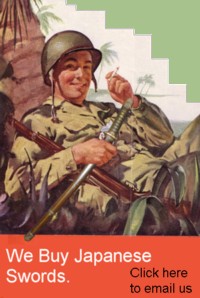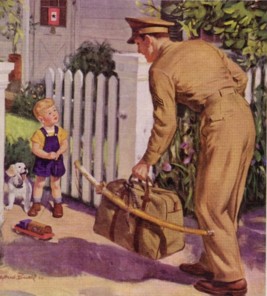SAMURAI SWORD 27 - KOTO BLADE
This is a Samurai Sword KOto blade dressed in the World War Two Imperial Japanese Army attire. Officers had the
option to either bring their own or buy older blades instead ofsporting the newer blades.
The blade is outfitted in the Japanese Imperial Army attire used during WWII. The handle and Tsuba were all standard
issue. The scabbard has a metal outer skin covering a wood insert. Two bands are placed, one near the throat and the other
in the opposite end. The upper band is bigger and holds a single suspension ring. The tip of the scabbard has a drag.
When attempting to identify a sword, it is important to note that the external components of the sword (handle, Tsuba,
scabbard, etc.) are all going to be identical if the sword was outfitted in WWII attire. Just because the external
apperance looks the same as the Koto blade shown here does not mean that the sword is a Koto blade.

This is a Hand-made blade. The Hammon is clearly visible through its entire length and all the way into the tip. The
blade has been polished, probably around WWII.

The following photo shows the Tsuba and its different components. The Tsuba had spacers above and below. These provided
the necessary height for the locking mechanism to operate properly.
In some instances the parts were stamped with production numbers. Ideally each piece would bear the same number which
is an indication that parts for the sword were never replaced. This particular example does not have any numbers.


|
The Samurai sword has a very rich history. The sword has been manufactured for several centuries and continues
to be produced today. The sword represented more than just a weapon. It was the soul of the Samurai warrior.
When attempting to identify the type of sword you have It is important to keep in mind that the fittings of
a sword (scabbard, handle, crossguard. etc.) may be identical from one sword to another. The reason why is
because during WWII the same fittings were used in all Army swords, Navy swords, etc. Armed forces are all
about uniformity. They strive to make everything the same.
This is the reason why a sword cannot be identified merely by its external appearance.
Understanding the different components that make up the Samurai sword is the first step in figuring out the
type of sword you have. That is the reason why we have created the
Understanding the Samurai sword section as a means to
provide a novice with the basic knowledge to start the path of determining the questions everyone has;
who made the sword, how old it is nad how much it is worth.
|

The handle is very nicely presented. Brown cloth wrapping is applied to nearly its entire length. The pommel has a
metal cap known as Kashira. Its design has a center opening on both sides with an ondulating contour. The front,
back and top bear a Chrysanthemum flower with leaves.
A hole is drilled and a metal sleeve is inserted in the hole. The lanyard ring is secured in the hole. Some of the
rings are plain. The one seen here has leaf designs applied to it.
The handle is covered in white ray skin which has a bumpy texture. A pair of Menuki are found in the handle, one on
each side. Their design consists of three flowers in a row. This was the official Menuki during WWII.


The following pictures show some of the components of a sword. Two wooden pegs go through
the holes in the tang to secure the blade to the handle. Soldiers would often make the peg by
inserting a chop stick in the hole of the tang, then proceeded to break it.
swords often displayed the signature of the maker, their title and school or village on the tang.
The example shown here is nicely signed.
|
This page is a recognition and identification guide for Samurai swords.
Multiple detailed photos of a specific sample are provided. Descriptions point
out clearly defined points that should be noted.
One of the most commonly asked questions is "How much is my Samurai Sword worth?".
A price guide is included here to address this question. The value of the swords is
reviewed over a period of several years. A trend can be observed. The present worth
of the edge weapons in the collector's market is illustrated.
This service is provided free of charge to the visitor/enthusiast courtesy of
MilitaryItems.com,
a company dedicated to the preservation of military history and to providing quality
military antiques and collectibles to museums, institutions and the general public.
|
|

The Tang has a rough appearance which is typical of Koto blades. A signature can be seen on one side but it is very
light and hard to read. The other side has not been signed or marked in any way.
Two holes have been drilled, they are very close togther. Only one of the holes is used when securing the handle in
place. The sword has been shortened. The end of the tang shows an angle.



|
WE BUY JAPANESE SWORDS - All types of Japanese edge weapons. Whether it is a WWII era Samurai sword or an
older type of blade.
The process gets started by you sending us an
Email .
We will respond to your inquiry normally within 24 hours and in many cases much faster.
We can tell you what you have, what it is worth and how much we can pay you.
One sword or an entire collection -
Email Us .
|
 |


The tsuba is the typical WWII style. Square shape with Chrysanthemum flowers on each corner. Base
metal construction and painted gold. This is a later war piece as the main body is solid and not
hollowed out.
This photo shows how the spacers fit. The metal ring at the base of the handle is also visible here. It is
nicely adorned with leaves and the same type of flowers as the Tsuba. The background is lightly pebbled.
A very attractive design.


By the Numbers
It is next to impossible to determine the exact number of Samurai swords that were produced and issued to
Japanese soldiers during the war. However, thanks to the record keeping maintained by the US Armed Forces,
it is possible to estimate how many swords were actually shipped home.
 |
There were over 500,000 Samurai swords were brought back home as souvenirs from the war.
There are several caviats to this number.
|
 |
For example, some soldiers took souvenirs and shipped them home circumbenting the established process.
Some of the swords were brought back inside duffle bags without anyone knowing except for the soldier who
captured the sword. This fact would clearly affect the final count.
The number also does not account for swords that were taken by Allied soldiers from other countries.
Collecting Samurai swords
Collecting Samurai swords is a field that has been growing since the days the GI's rummaged around Asia
bringing back military souvenirs. Japanese soldiers carried many of these swords when they went to
battle. Once the soldier was killed or captured, the Americans would take the edge weapons as war trophies.
Eventually all these pieces came back to the United States where military history enthusiasts began to collect them.
 |
In trying to determine if you should collect Samurai swords there are certain factors that should be
considered.
The adjacent table outlines some of the advantages and disadvantages of collecting the Samurai swords.
|
 |
This Samurai Sword may be currently reproduced.
It is becoming more difficult to be able to tell the fake ones from the real ones because
the quality of the reproductions is improving. The collector must become familiarized with
the construction style and materials employed in the manufacturing of this item.
Attention to the details is critical in order to be able to determine the authenticity of
the collectible.
If you have an interest is seeing other Japanese Samurai swords, you can do so by going to our
Japanese Samurai Swords Price Guide
identification guide. Where we cover Samurai swords from all periods.
| 




